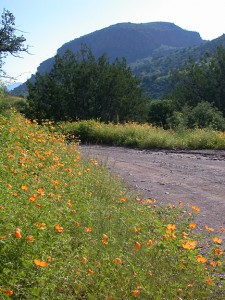
For many parts of New Mexico and Arizona, this year’s Monsoon rains have remained spotty and below average (see the CLIMAS Southwest Monsoon Tracker) But not so here at Casitas de Gila Guesthouses! As of today, we have received over 9 inches of rain since early July (which marked the beginning of this year’s Monsoon Season), with the result that the lands of the Casitas de Gila Nature Preserve are now luxuriously green. There are wildflowers growing in profusion everywhere.
Based on the latest 10-day forecast, this week will probably see the end of this year’s Monsoon Season as Summer begins to fade. The early signs of Fall are everywhere now. Yesterday there was a widespread, gentle, all-day rain, but it seemed more a Fall type of rain than Monsoonal. This morning it dawned clear, cool and actually brisk, with temperatures in the high 50s. Many of our summer birds have already gone. Yesterday, while driving back from Silver City, there was a small group of Turkey Vultures perched in a circle on some yuccas and fence posts at the side of the road. They do this every year shortly before migrating back to Mexico. It’s the only time those Turkey Vultures gather together like this. Whether or not they do it to go over various route options and departure times remains an open question. And then this morning, we observed over a hundred Cliff Swallows packed side by side on the power lines near the entrance to Casitas de Gila. It won’t be long before they will be leaving as well.
There are signs along Bear Creek, too. Looking out from the Casitas these days upon the deep green foliage of the Bear Creek floodplain, here and there one’s eye will be drawn to an occasional branch high up in the Cottonwoods whose leaves have already turned golden yellow. One observes this phenomena every year about this time. With the general Fall turning-of-the-leaves still a good month off, this early turning phenomena remains an unsolved mystery. Could it be some sort of isolated Cottonwood stress? Possibly the result of partially broken limbs from that big thunderstorm in July? Or, to fantasize a bit, maybe it’s some sort of early warning system that these Cottonwoods, ancient Patriarchs of the Floodplain, use to signal the other denizens of the Creek bottom that Fall is on the way? So many interesting observations to ponder … But on this morning such rumination must wait, for today it is the magnificence of the late Summer Flowers now surrounding the Casitas that commands our attention, and demands a photographic journey to the Creek below.
Hiking down from the Casitas and along the Corral Road, at each bend and turn in the trail an incredibly diverse array of wildflowers greets one’s eye. The walk progresses ever more slowly as one’s journey is repeatedly brought to a halt. Again and again the photographer’s eye is arrested by those especially lit places where blossoms radiate with an unbelievable crystalline brilliance, as rays of sunlight filtering through the deep green canopy above refract in the lingering drops of the early morning dew.
The diversity of flowers this morning is perhaps the greatest we have seen in our 13 years here. Perhaps, this is due to the complete lack of rain for the first half of this year. The life cycles of most of the plants native to this area respond more to the occurrence of rain rather than the seasons. With no rain until July, many species that would normally bloom in the Spring and Early Summer are this morning found blooming with the Late Summer varieties. The day is perfect for photography and the flowers and camera cooperate fully. After about an hour and a half, the Sun has risen high enough to both heat things up as well as eliminate most of the wonderful contrast of light and shadows that has been so captivating. Time to pack up and head back to the studio to view the results of the morning’s endeavors.
After sorting through the 170 or so photos, some 21 different flowering plants are recognized, either old friends known from the past or new ones which are easily identified. Another 10, mostly those difficult little yellow ones that look so much alike, will take longer to key out.
May the joy you have in viewing these photos be as great as as I had in taking them!
**Click on the photo and a larger version will open in a new window.
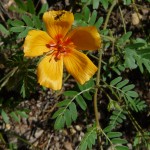
(Kallstroemia grandiflora)
SUMMER POPPY (Kallstroemia grandiflora)
Not a true poppy, this plant is related to the creosote bush! It doesn’t bloom every year, having germination inhibitors coating the seeds that require several seasons to wash off. Here at the Casitas, when they do germinate and bloom, the hillsides are literally covered with them, as they are right now!
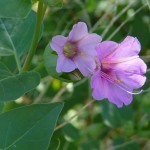
(Mirabilis multiflora)
WILD FOUR O’CLOCK (Mirabilis multiflora)
One of our favorites here at Casitas de Gila Guesthouses. These flowers open late in the afternoon and close in the morning when the Sun reaches them. At night they emit a musky odor which attracts the large hawkmoth, the dominant pollinator for the plant.
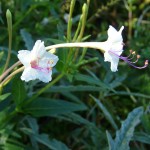
LONG-FLOWERED FOUR O’CLOCK (Mirabilis longiflora)
Like the Wild Four O’Clock these flowers unfold at dusk and shrivel with the day. Only a few hawkmoths have long enough tongues to feed on these flowers and are their only pollinators. Whereas the Wild Four O’Clock grows around the Casitas, this species prefers the much damper soils down along the Creek.
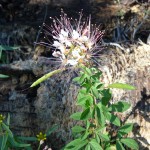
(Polanisia dodecandra)
CLAMMYWEED (Polanisia dodecandra)
So named because of the sticky hairs that line their stems. Found along the dry washes at the Casitas.
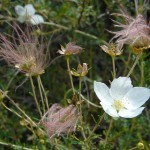
(Fallugia paradoxa)
APACHE PLUME (Fallugia paradoxa)
A member of the Rose Family, this plant takes the form of a small shrub, 3-6 feet high. The flowers are large, five-petaled and cup shaped, which after blooming produce pinkish-plumed fruits.
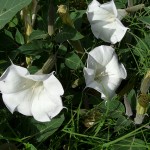
(Datura meteloides)
SACRED DATURA (Datura meteloides)
A premier hallucinogenic plant of Southwest Native Americans, every part of this plant, including roots, stems, leaves and flowers, is toxic, dangerous and can cause death when ingested. Absolutely not to be fooled with! Having said that, its large, 6-inch white trumpet or lily-like blossoms are as gorgeous as they are prolific. Found everywhere in our area, they are abundant all over the Casita lands. Like the Four O’Clocks, their long blossoms unfurl at dusk and curl back up by mid-morning. They also are pollinated mainly by hawkmoths, which become quite intoxicated by the nectar as they stagger around on the plant and then wend a crooked flight off to the next flower! The nature of their strong perfume is strictly in the nose of the beholder, some people find it exotically attractive, while others totally abhor it!
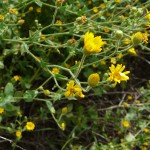
(Heterotheca subaxillaris)
TELEGRAPH PLANT or CAMPHORWEED (Heterotheca subaxillaris)
A very widespread weed in the U.S., the Telegraph Plant is just one of the approximately 20,000 members of the Sunflower Family. Bane of farmers, ranchers, and the Casitas’ Maintenance Man it is very prolific in germination and virtually impossible to eradicate. Its alternate common name comes from the camphor-like odor given off when crushed.
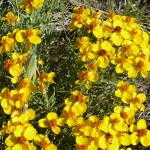
(Zinnia grandiflora)
PRAIRIE ZINNIA (Zinnia grandiflora)
Another member of Sunflower Family, each ray of the yellow blossom is a separate flower and in the disk-like center of the head are another two dozen tubular flowers. Both types of flowers produce seeds; the ray flower seeds are dispersed on the wind by the wing-like dried rays, while the disk flower seeds drop to the ground near the base of the plant. Clumps of these flowers are found throughout the Casita upland flats and hills.
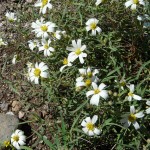
(Zinnia acerosa)
DESERT ZINNIA (Zinnia acerosa)
Very similar to the Prairie Zinnia, except that the blossoms are white instead of yellow, and the central disk has only 6 to 8 central tubular flowers. It thrives in caliche-rich soils, and can be found in the washes around the Casitas.
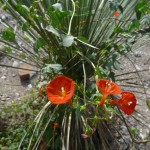
(Ipomoea coccinea)
SCARLET CREEPER (Ipomoea coccinea)
The delicate brilliant scarlet tubular flowers of this creeping vine-type plant are a favorite attraction for the hummingbirds here at the Casitas. A member of the Morning Glory Family, their bright scarlet flowers are vibrant in the morning Sun against the deep green leaves of the plants that they climb.
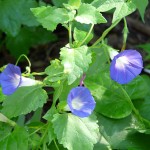
(Ipomoea hirsutula)
MEXICAN MORNING GLORY (Ipomoea hirsutula)
A member of the Morning Glory family, the Mexican Morning Glory opens for business at Sunrise and closes just 4 or 5 hours later, encouraging the pollinating bees to get up and get going! The violet blue of the outer blossom becomes whitish at the interior base. Whether viewed in the shade or back lit by the Sun ,it is simply gorgeous against the deep green leaves of the vine.
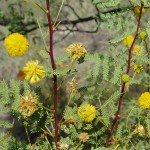
(Acacia constricta)
WHITE THORN (Acacia constricta)
This thorny little shrub is easily recognized by its thorns, delicate compound leaflets, and the little fluffy, ball-shaped flowers that bloom, depending on rain, both in the Spring and in the Summer. A beautiful plant which initially might be confused with the more densely foliaged Cat Claw or Wait-A-Minute Bush, White Thorn is fairly common on the rocky cliffs and hillsides leading down to the Creek.
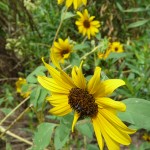
(Helianthus annuus)
COMMON SUNFLOWER (Helianthus annuus)
Abundant along roadsides and fields throughout the Southwest, this plant is prolific along the margins of Bear Creek and the Gila Valley in Late Summer. Pre-Columbian Hopi tribes domesticated a large-headed variety of this plant, the seeds of which were used as food and a source of dye in basket making. The Spaniards introduced seeds from this plant to Europe, which was further developed in Russia into varieties having a much larger head. Subsequently, the seeds of this giant variety were brought back to the U.S. where today it is a widely-grown crop for use as bird seed, vegetable oil, and, of course, human snack food!
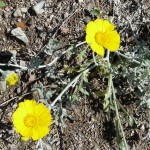
(Baileya multiradiata)
DESERT MARIGOLD (Baileya multiradiata)
When little or nothing else is blooming, and the ground is seemingly bone dry, as long as the weather is good and warm you can often find this interesting little plant along the roadsides and dry washes at the Casitas. Another member of the Sunflower family, Desert Marigolds flaunt bright yellow multi-petaled flowers on tall, spindly, and gracefully-arcing blue-green stems; as such they are truly an eye catcher and a photographer’s delight.
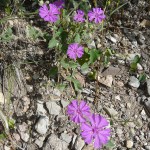
(Allionia incarnata)
UMBRELLA WART (Allionia incarnata)
This pretty little plant is found creeping along the ground near the dry washes at the Casitas. The purplish-pink flowers are actually a composite of three flowers which open at Sunrise and close at mid-day to early afternoon. They are a member of the Four O’Clock family.
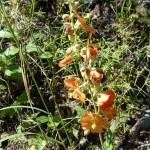
(Sphaeralcea fendleri)
FENDLER GLOBEMALLOW (Sphaeralcea fendleri)
This member of the Mallow family grows in the form of tall vertical spikes covered in abundant orange to red cup-shaped flowers. It is found in all parts of Casita lands and serves as a browse for deer.
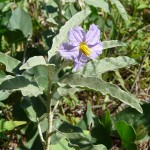
(Solanum elaeagnifolium)
SILVERLEAF NIGHTSHADE (Solanum elaeagnifolium)
This plant with purple flowers and yellow centers is one of several members of the Nightshade family found in our area. Sharp, hair-like spines cover the stems and wavy, elongated leaves of this plant, which after flowering puts out round, green-striped fruit that turn yellow when ripe. The fruit is poisonous. Abundant in dry sandy soils, it is considered a native ornamental plant by some because of its colorful flowers; here at the Casitas, however, it persists as a highly invasive, prickly, and undesirable species that is virtually impossible to eradicate!
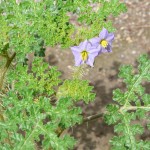
(Solanum heterodoxum)
MELLONLEAF NIGHTSHADE (Solanum heterodoxum)
This local Nightshade family member has a flower that is almost identical to the Silverleaf Nightshade. Its leaves, however, are very different, having highly intricate, crenulated margins. This species is even more prickly; interesting to look at but not much fun to touch.
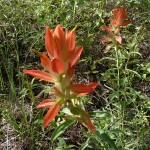
(Castilleja integra)
SOUTHWEST INDIAN PAINTBRUSH (Castilleja integra)
The Indian Paintbrush is an unusual plant having bright red floral bracts. Reportedly there are some 200 different species of Indian Paintbrush in Western North America. Here in the Gila area, there are at least four different species which grow at different elevations. Most species of Indian Paintbrush are hemiparasitic, depending on host plants for water and nutrients. Below the surface of the ground the plant has tubes which attach to the roots of the host plant, such as oaks or grasses.
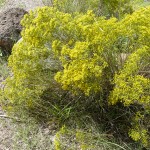
(Gutierrezia microcephala)
SNAKEWEED (Gutierrezia microcephala)
Snakeweed is another common weed in our area that is detested by ranchers because it is not eaten by cattle and it quickly multiplies to take over and degrade range land. Yet another member of the Sunflower Family, it puts out a massive flowering of tiny yellow flowers in Late Summer on a dense, fan-like array of thin, bright green stems. Yet while the plant is a bane to the rancher, traditionally it has been a treasured pharmaceutical for Native Americans and Hispanics in the Southwest, who make a tea from the leaves and stems for treating malaria, rheumatism, and snakebite.
REFERENCES:
Vascular Plants of the Gila Wilderness. Presented in Association with the Western New Mexico university Department of Natural Sciences.
1987, Janice Emily Bowers, 100 Roadside Wildflowers of Southwest Woodlands, Southwest Parks and Monuments Association, Tucson, Arizona.
1989, Janice Emily Bowers, 100 Desert Wildflowers, Southwest Parks and Monuments Association, Tucson, Arizona.
2000, Steve West, Northern Chihuahuan Desert Wildflowers, Carlsbad Caverns-Guadalupe Mountains Association, A Falcon Guide.


